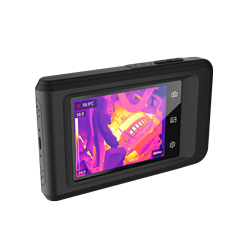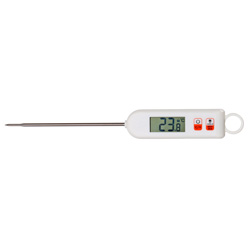| 7142 SEK | (8927.50 SEK inkl. moms) |
|
|
Leverans - omgående
|
Var är väggen dåligt isolerad, hur sprids värmen i kaffekoppen, kan rörelseenergi övergå till värmeenergi?
Ta en bild och studera den i kameran, på datorn, i surfplattan eller på din telefon.
Lätthanterlig värmekamera med flera smarta funktioner. Tack vare den inbyggda kamerafunktionen tas både en värmebild och en visuell kamerabild samtidigt vilket underlättar vid rapportskrivning. Bilderna kan överföras till en dator där de kan studeras och bearbetas i den kostnadsfria programvaran Hikmicro Analyzer. Med samma app kan du dessutom streama i realtid. Kameran är även utrustad med WiFi och kan anslutas till en surfplatta eller mobiltelefon.
Läs mer, hämta programvara och manual.
Experiement - Se skillnad på temperatur och värme (pdf)
Fabrikat: Hikmicro Pocket2.
Temperaturområde: -20 °C till + 400 °C.
Noggrannhet: ± 2°C eller 2 %.
Upplösning termisk: 256x192 pixlar.
Synfält termisk: 50°H x 37,2°V.
Funktioner: Ställbar emissionsfaktor, inbyggt minne 16 GB, temperaturlarm, videostreaming.
Upplösning kamera: 3264x2448 pixlar.
Upplösning video: 640x480 pixlar.
Synfält kamera: 50°H x 37,2°V.
Display: 3,5" färgskärm (640x480 pixlar).
Digital zoom: 1–4 ggr.
Strömförsörjning: Inbyggt Li-Ionbatteri. Laddare medföljer.
Anslutning: Medföljande USB-kabel används för streaming och filöverföring till en dator (PC). Via kamerans WLAN eller hotspot kan man streama till en mobiltelefon eller surfplatta.
Uttag: USB C för laddning och bildöverföring.
Mått: 138x85x24 mm.
Vikt: 220 g.
Tillbehör: Handlovsrem, fodral samt USB-kabel för laddning och bildöverföring medföljer.
Garanti: 1 år.
Bildserien med två bilder:
En kula släpptes från två meters höjd ned mot en asfaltsyta. Direkt efter nedslaget togs en bild (en visuell kamerabild och en värmebild). Den vänstra punkten på bilderna visar nedslagsplatsen och den högra är kulan.
Bilden visar tydligt att kulans rörelseenergi övergick till värmeenergi vid nedslaget.
Bildserien med fyra bilder:
Bildserien är tagen då kaffe slås upp i en porslinsmugg.
Hur ser det ut om man istället använder en plastmugg?

